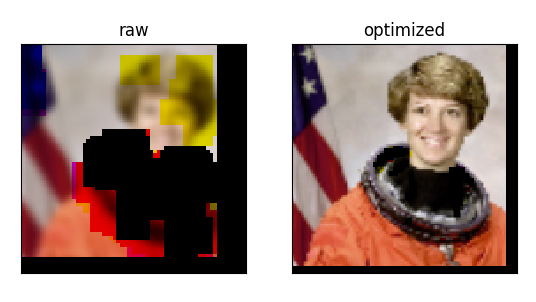The delayed_image module
Project description
Ports the following from kwcoco:
ChannelSpec
SensorChannelSpec
DelayedLoad & other delayed operations
Delayed Loading
Example of delayed loading:
>>> from delayed_image import DelayedLoad
>>> import kwimage
>>> fpath = kwimage.grab_test_image_fpath(overviews=3)
>>> dimg = DelayedLoad(fpath, channels='r|g|b').prepare()
>>> quantization = {'quant_max': 255, 'nodata': 0}
>>> #
>>> # Make a complex chain of operations
>>> dimg = dimg.dequantize(quantization)
>>> dimg = dimg.warp({'scale': 1.1})
>>> dimg = dimg.warp({'scale': 1.1})
>>> dimg = dimg[0:400, 1:400]
>>> dimg = dimg.warp({'scale': 0.5})
>>> dimg = dimg[0:800, 1:800]
>>> dimg = dimg.warp({'scale': 0.5})
>>> dimg = dimg[0:800, 1:800]
>>> dimg = dimg.warp({'scale': 0.5})
>>> dimg = dimg.warp({'scale': 1.1})
>>> dimg = dimg.warp({'scale': 1.1})
>>> dimg = dimg.warp({'scale': 2.1})
>>> dimg = dimg[0:200, 1:200]
>>> dimg = dimg[1:200, 2:200]
>>> dimg.write_network_text()
╙── Crop dsize=(128,130),space_slice=(slice(1,131,None),slice(2,130,None))
└─╼ Crop dsize=(130,131),space_slice=(slice(0,131,None),slice(1,131,None))
└─╼ Warp dsize=(131,131),transform={scale=2.1000}
└─╼ Warp dsize=(62,62),transform={scale=1.1000}
└─╼ Warp dsize=(56,56),transform={scale=1.1000}
└─╼ Warp dsize=(50,50),transform={scale=0.5000}
└─╼ Crop dsize=(99,100),space_slice=(slice(0,100,None),slice(1,100,None))
└─╼ Warp dsize=(100,100),transform={scale=0.5000}
└─╼ Crop dsize=(199,200),space_slice=(slice(0,200,None),slice(1,200,None))
└─╼ Warp dsize=(200,200),transform={scale=0.5000}
└─╼ Crop dsize=(399,400),space_slice=(slice(0,400,None),slice(1,400,None))
└─╼ Warp dsize=(621,621),transform={scale=1.1000}
└─╼ Warp dsize=(564,564),transform={scale=1.1000}
└─╼ Dequantize dsize=(512,512),quantization={quant_max=255,nodata=0}
└─╼ Load channels=r|g|b,dsize=(512,512),num_overviews=3,fname=astro_overviews=3.tif
>>> # Optimize the chain
>>> dopt = dimg.optimize()
>>> dopt.write_network_text()
╙── Warp dsize=(128,130),transform={offset=(-0.6...,-1.0...),scale=1.5373}
└─╼ Dequantize dsize=(80,83),quantization={quant_max=255,nodata=0}
└─╼ Crop dsize=(80,83),space_slice=(slice(0,83,None),slice(3,83,None))
└─╼ Overview dsize=(128,128),overview=2
└─╼ Load channels=r|g|b,dsize=(512,512),num_overviews=3,fname=astro_overviews=3.tif
#
>>> final0 = dimg.finalize(optimize=False)
>>> final1 = dopt.finalize()
>>> assert final0.shape == final1.shape
>>> # xdoctest: +REQUIRES(--show)
>>> import kwplot
>>> kwplot.autompl()
>>> kwplot.imshow(final0, pnum=(1, 2, 1), fnum=1, title='raw')
>>> kwplot.imshow(final1, pnum=(1, 2, 2), fnum=1, title='optimized')
SensorChanSpec
Includes the SensorChan spec, which makes handling channels from different sensing sources easier.
It has a simple grammar:
// SENSOR_CHAN_GRAMMAR ?start: stream // An identifier can contain spaces IDEN: ("_"|"*"|LETTER) ("_"|" "|"-"|"*"|LETTER|DIGIT)* chan_single : IDEN chan_getitem : IDEN "." INT chan_getslice_0b : IDEN ":" INT chan_getslice_ab : (IDEN "." INT ":" INT) | (IDEN ":" INT ":" INT) // A channel code can just be an ID, or it can have a getitem // style syntax with a scalar or slice as an argument chan_code : chan_single | chan_getslice_0b | chan_getslice_ab | chan_getitem // Fused channels are an ordered sequence of channel codes (without sensors) fused : chan_code ("|" chan_code)* // A channel only part can be a fused channel or a sequence channel_rhs : fused | fused_seq // Channels can be specified in a sequence but must contain parens fused_seq : "(" fused ("," fused)* ")" // Sensors can be specified in a sequence but must contain parens sensor_seq : "(" IDEN ("," IDEN)* "):" sensor_lhs : (IDEN ":") | (sensor_seq) sensor_chan : sensor_lhs channel_rhs? nosensor_chan : channel_rhs stream_item : sensor_chan | nosensor_chan // A stream is an unordered sequence of fused channels, that can // optionally contain sensor specifications. stream : stream_item ("," stream_item)* %import common.DIGIT %import common.LETTER %import common.INT
You can think of a channel spec is that splitting the spec by “,” gives groups of channels that should be processed together and “late-fused”. Within each group the “|” operator “early-fuses” the channels.
For instance, say we had a network and we wanted to process 3-channel rgb images in one stream and 1-channel infrared images in a second stream and then fuse them together. The channel specification for channels labled as ‘red’, ‘green’, ‘blue’, and ‘infrared’ would be:
infrared,red|green|blueSensors can be included with a colon prefix. Parenthesis can be used for grouping.
S2:(infrared,red|green|blue)Project details
Release history Release notifications | RSS feed
Download files
Download the file for your platform. If you're not sure which to choose, learn more about installing packages.
Source Distribution
Built Distribution
Hashes for delayed_image-0.2.0-py3-none-any.whl
| Algorithm | Hash digest | |
|---|---|---|
| SHA256 | 04f7b7c01002cd78d81a91efcb39d82f360aef28bce0323e4ed9125ef1603f2c |
|
| MD5 | 22f607be811b7fccafa0466455e82c8c |
|
| BLAKE2b-256 | 348ed79304c0b5bb5f778aaa83962659ffe07ccdbadaa35d261fe2561863d756 |














